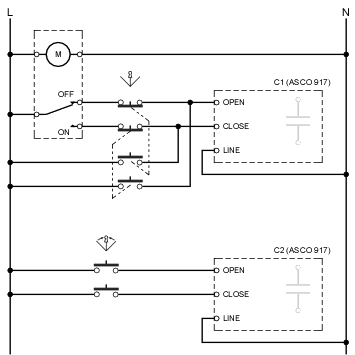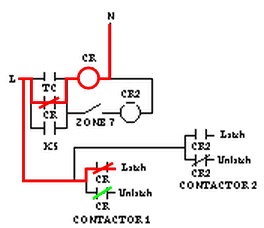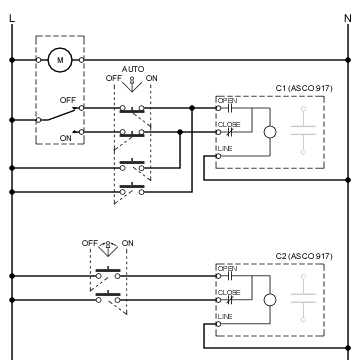Some additional notes regarding key switch. I depicted the switch with center position key-removal. This means the key can only be removed when control is returned to time clock. Order the appropriate key-removal configuration if removal under either or both override conditions is desired.I'm fairly certain this will work...
You are using an out of date browser. It may not display this or other websites correctly.
You should upgrade or use an alternative browser.
You should upgrade or use an alternative browser.
lighting relays and time clock
- Thread starter Oohitec
- Start date
- Status
- Not open for further replies.
hillbilly1
Senior Member
- Location
- North Georgia mountains
- Occupation
- Owner/electrical contractor
I'm fairly certain this will work...

Too bad you can't see my diagram, its much simpler to use the relay, and if the engineer wants the lighting override to reset the next cycle, the key switch with the multiple contacts will not work because of the maintained contacts. It would be easier to design if we knew exactly what the engineer/customer was wanting to happen.
I zoomed in and see enough to know yours won't work. As soon as CR is triggered, Contactor 1 is all locked up (electrically latched)...Too bad you can't see my diagram, its much simpler to use the relay, ....

That's why I made it center-position key removal. In order to return control to the time clock, the key must be removed... and no waiting till the next time clock cycle. We have to assume whomever is doing the overriding is not going to want to leave their key in the switch....and if the engineer wants the lighting override to reset the next cycle, the key switch with the multiple contacts will not work because of the maintained contacts.
There are alternitives using a momentary key switch and a control relay (or two, depending on the functionality desired), perhaps even add an auxiliary contact on Contactor 1.... and that leads us to...
It would be easier to design if we knew exactly what the engineer/customer was wanting to happen.
hillbilly1
Senior Member
- Location
- North Georgia mountains
- Occupation
- Owner/electrical contractor
I zoomed in and see enough to know yours won't work. As soon as CR is triggered, Contactor 1 is all locked up (electrically latched)...

Oops! I'm used to photocell on, time clockoff circuits! Good catch! Remove the holding contact "CR" and it will work fine. I was going by what the engineer drawn assuming that was his intention, I can still do it, I just have to add a N/C contact to the time clock and put contact "CR" in series with it, then parrallel both with the key switch and other time lock "N/O" contact. That will reset the holding contact when the time clock changes state. Otherwise a maintained contact on the keyswitch will have to be used.
hillbilly1
Senior Member
- Location
- North Georgia mountains
- Occupation
- Owner/electrical contractor
That's why I made it center-position key removal. In order to return control to the time clock, the key must be removed... and no waiting till the next time clock cycle. We have to assume whomever is doing the overriding is not going to want to leave their key in the switch.
There are alternitives using a momentary key switch and a control relay (or two, depending on the functionality desired), perhaps even add an auxiliary contact on Contactor 1.... and that leads us to...
The problem with the center position key removal is once you turn the key back, until it is turned back to auto, the time clock will no longer control the load, so then your hunting down somebody with a key to reset it. Also the engineer shows the second contactor controlled by the time clock also, where your diagram has keyswitch control only. Or do you mean a two position switch?
Last edited:
hillbilly1
Senior Member
- Location
- North Georgia mountains
- Occupation
- Owner/electrical contractor
Oops! I'm used to photocell on, time clockoff circuits! Good catch! Remove the holding contact "CR" and it will work fine. I was going by what the engineer drawn assuming that was his intention, I can still do it, I just have to add a N/C contact to the time clock and put contact "CR" in series with it, then parrallel both with the key switch and other time lock "N/O" contact. That will reset the holding contact when the time clock changes state. Otherwise a maintained contact on the keyswitch will have to be used.
I take that back, "CR" would not reset doing that, I would have to add another relay for the holding circuit. That's what I get shooting from the cuff and not thinking it through!
No. The contact blocks only operate while the key is turned (one side, two blocks - one N.O to trigger C1, one N.C to isolate the time clock). When the key is turned back to the center position for removal, the contact blocks return to their normal states. Because the time clock output is constant, it will trigger C1 to the state of the time clock. It amounts to center position is AUTO... no special reset required.The problem with the center position key removal is once you turn the key back, until it is turned back to auto, the time clock will no longer control the load, so then your hunting down somebody with a key to reset it.
From what I see, the second contactor (C2) isn't controlled by anything. The designer shows a switch (m) connected from the OPEN to the CLOSE terminals.... which of course will not function.Also the engineer shows the second contactor controlled by the time clock also, where your diagram has keyswitch control only. Or do you mean a two position switch?
Judging from the connection of the contacts, C2's purpose is to bypass the five "B" subzone switches, turning on all Zone B lights. Keyswitch control is all that is necessary if manual only operation is desired. But regardless of how it is controlled, it would only turn lights on when C1 is CLOSED.
hillbilly1
Senior Member
- Location
- North Georgia mountains
- Occupation
- Owner/electrical contractor
No. The contact blocks only operate while the key is turned (one side, two blocks - one N.O to trigger C1, one N.C to isolate the time clock). When the key is turned back to the center position for removal, the contact blocks return to their normal states..
If you are using it as a three position switch, you will need more contacts, because the cam will only override it to the same state whether you turn it left or right, I assume you are wanting to turn off when left, on when right, with center auto. You do not have enough contacts to do that. That's why it's effectively a two position switch unless you add more contacts. No biggie to do though. As we both have said, until we find out what the engineer wants, it's all speculation.
Look at it again.If you are using it as a three position switch, you will need more contacts, because the cam will only override it to the same state whether you turn it left or right, I assume you are wanting to turn off when left, on when right, with center auto. You do not have enough contacts to do that. That's why it's effectively a two position switch unless you add more contacts. No biggie to do though. As we both have said, until we find out what the engineer wants, it's all speculation.
When you turn the key to left "off" position, only the left switch blocks change state. Left N.C. opens, breaks time clock ON to C1 CLOSE. Left N.O. closes, makes L to C1 OPEN. If the time clock status is OFF, then effectively no change in C1 status. If the time clock state is ON, then it has effectively removed time clock ON from cycling C1 status.
When you turn the key to the right position, the right blocks change state. Left N.C. opens, breaks time clock OFF to C1 OPEN. Left N.O. closes, makes L to C1 CLOSE. If the time clock status is ON, then effectively no change in C1 status. If the time clock state is OFF, then the right N.C. block has effectively removed time clock OFF from cycling C1 status.
When the key is returned to the center position, switch blocks return to their normal state. Control is returned to the time clock through both N.C. blocks Whatever state the time clock is in at the time, it will trigger C1 to the matching state, i.e. time cock ON/OFF, C1 CLOSE/OPEN respectively, if C1 is in the opposite state. Don't forget about the clearing contacts in C1.
hillbilly1
Senior Member
- Location
- North Georgia mountains
- Occupation
- Owner/electrical contractor
Perhaps this will make it a bit clearer...

I see what your doing now, it's all in the key switch cam. Two N/O N/C blocks on the opposite sides of the cam, your only breaking one leg of the time clock at a time instead of both, which works too. I was looking at breaking both time clock legs, taking it totally out of the circuit. But doing it the way you are, it is not necessacary.
Correct. Only have to break the one that would cycle C1.I see what your doing now, it's all in the key switch cam. Two N/O N/C blocks on the opposite sides of the cam, your only breaking one leg of the time clock at a time instead of both, which works too. I was looking at breaking both time clock legs, taking it totally out of the circuit. But doing it the way you are, it is not necessacary.
hillbilly1
Senior Member
- Location
- North Georgia mountains
- Occupation
- Owner/electrical contractor
Until the OP gets back to us on what the owner wants, that will decide which control scheme he will have to use. I have a feeling they do not want to leave the key in the switch once it is overridden due to public access. Of course they could use one that the key could be removed in any position.
fmtjfw
Senior Member
- Location
- Fairmont, WV, USA
Yeah I do have two ASCO relays and all the voltage is 277V. I'm not sure if the clock is momentary but the way they intend it to operate is for the clock to override everything in case they forget to shut the lights manually.
None of the schemes so ably designed and drawn (beautiful work I might add):happyyes: meets the original requirement spelled out by the OP. You can't meet the original requirement without an additional timer somewhere. You can't have the clock turn off the lights, the key switch override that, and the clock override the key switch. Not enough "states" in Computer Science speak. UNLESS the lights are normally off, only turned on by the key switch, and never on when the clock says off, but that doesn't make a lot of sense.
I hear what you are saying... and you are correct about not meeting the requirements stated in the OP... but you have to take those requirements with a grain of salt when they are stated by someone that don't know whether a time clock needs a neutral (sorry Oohitec, no offense intended... we all have to go through the learning process... and ain't one of us that have totally succeededNone of the schemes so ably designed and drawn (beautiful work I might add):happyyes: meets the original requirement spelled out by the OP. You can't meet the original requirement without an additional timer somewhere. You can't have the clock turn off the lights, the key switch override that, and the clock override the key switch. Not enough "states" in Computer Science speak. UNLESS the lights are normally off, only turned on by the key switch, and never on when the clock says off, but that doesn't make a lot of sense.
Scheme(s) presented by myself are a cross between info gleaned from the OP'er and the drawing, with more weight given to the drawing :roll:.
hillbilly1
Senior Member
- Location
- North Georgia mountains
- Occupation
- Owner/electrical contractor
None of the schemes so ably designed and drawn (beautiful work I might add):happyyes: meets the original requirement spelled out by the OP. You can't meet the original requirement without an additional timer somewhere. You can't have the clock turn off the lights, the key switch override that, and the clock override the key switch. Not enough "states" in Computer Science speak. UNLESS the lights are normally off, only turned on by the key switch, and never on when the clock says off, but that doesn't make a lot of sense.
It can be done, I just have to add another relay for the isolating the holding contact, use a momentary key switch. When the time clock changes back to the "On" state, the N/C contact on the time clock opens, releasing the holding contact. I have to sit down and draw up this anyway, because I just remembered I have a customer wanting the same thing for a baseball field this fall. They want the time clock to turn off the load if the coaches forget to turn the lights off on days they normally don't have games.
fmtjfw
Senior Member
- Location
- Fairmont, WV, USA
It can be done, I just have to add another relay for the isolating the holding contact, use a momentary key switch. When the time clock changes back to the "On" state, the N/C contact on the time clock opens, releasing the holding contact. I have to sit down and draw up this anyway, because I just remembered I have a customer wanting the same thing for a baseball field this fall. They want the time clock to turn off the load if the coaches forget to turn the lights off on days they normally don't have games.
Yes, clearing the override on the next "clock on" event is easily doable. When the "clock off" contact opens you just lose the seal-in of the CR relay. It's a standard start -- stop control, even if the stop is on one side of the relay coil and start is on the other side.
- Location
- Tennessee NEC:2017
- Occupation
- Semi-Retired Electrician
I hear what you are saying... and you are correct about not meeting the requirements stated in the OP... but you have to take those requirements with a grain of salt when they are stated by someone that don't know whether a time clock needs a neutral (sorry Oohitec, no offense intended... we all have to go through the learning process... and ain't one of us that have totally succeeded).
Scheme(s) presented by myself are a cross between info gleaned from the OP'er and the drawing, with more weight given to the drawing :roll:.
Smart $.....what are you using to draw the ladder logic diagrams?
I like it!:thumbsup:
Canvas <-- link. Current version is 14. I'm still using v12. I've been a Canvas user since v4, circa 1998. There's nothing "automated" in drawing the diagram... but being adept with the program, I do make use of its time-saving features.Smart $.....what are you using to draw the ladder logic diagrams?
I like it!:thumbsup:
- Status
- Not open for further replies.

